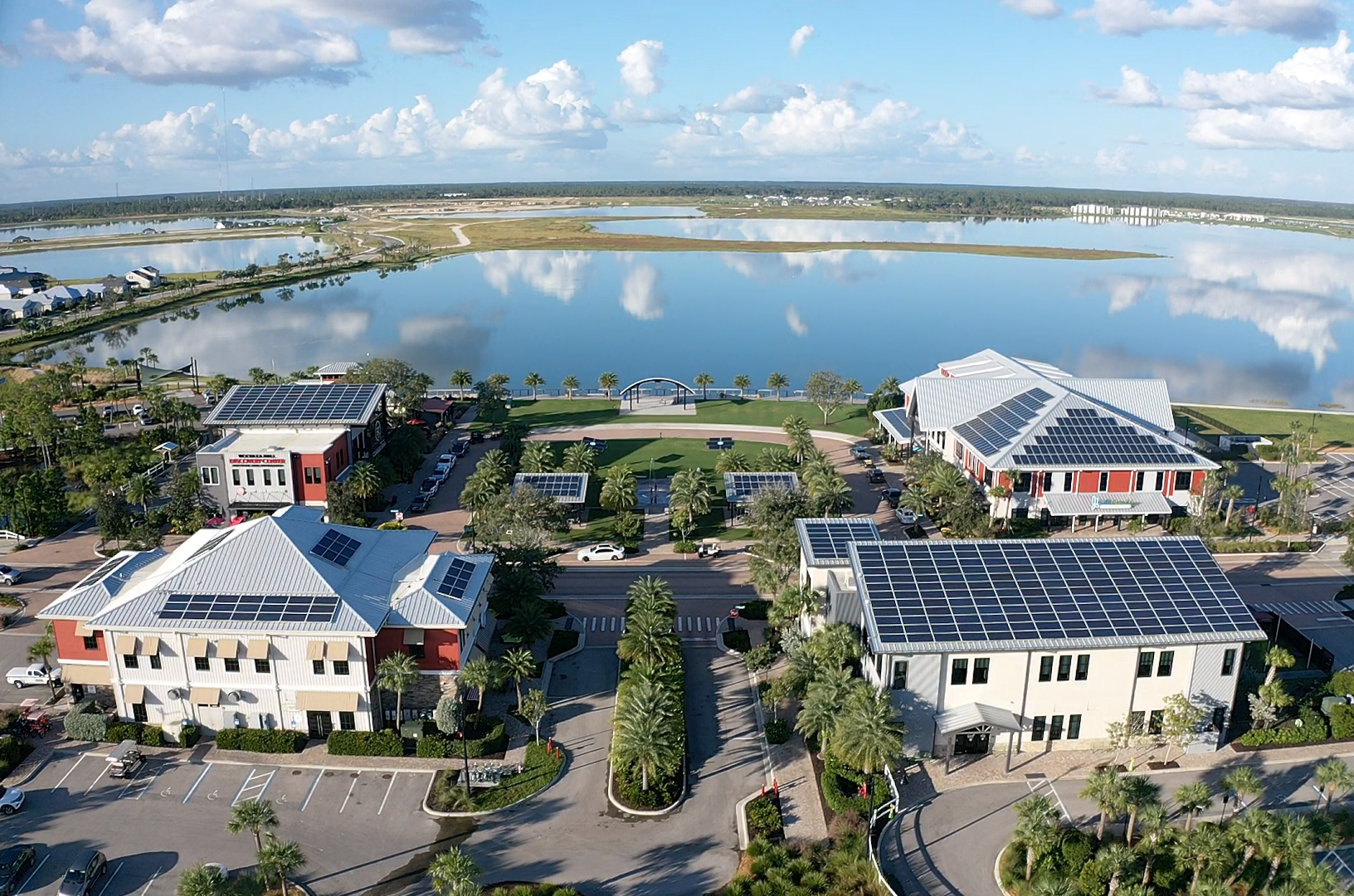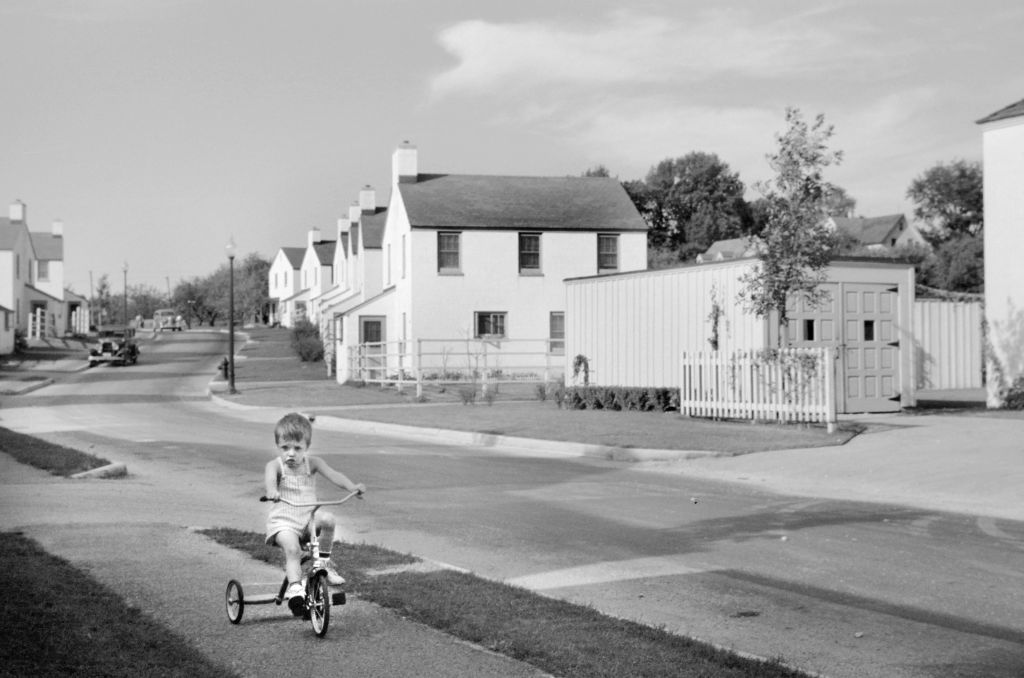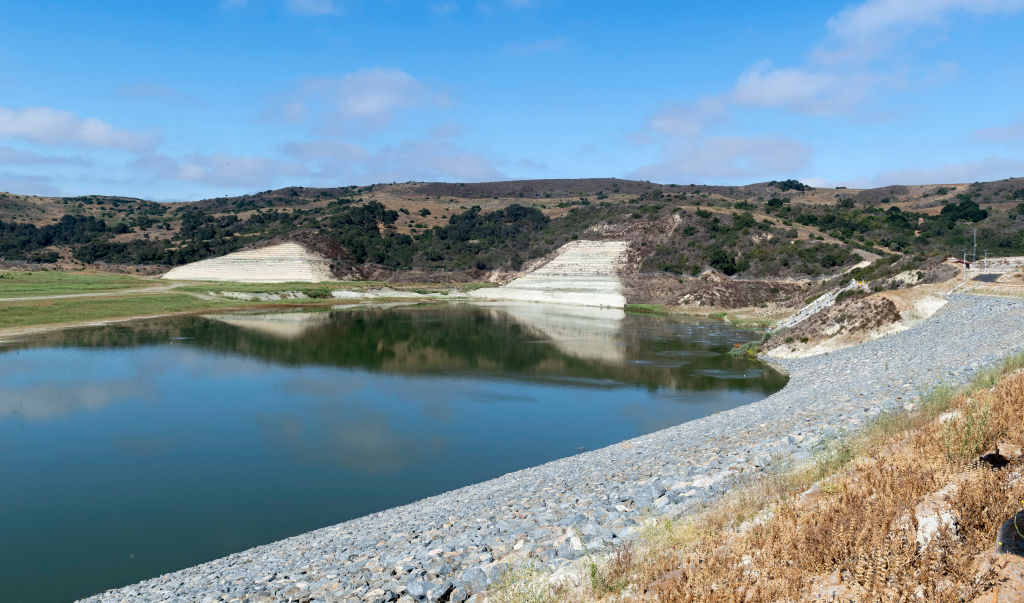
In the aftermath of Hurricane Ian, which hit Florida’s southwest coast on Sept. 28 as a Category 4 storm, all eyes turned to one town. Just a few miles from places like Fort Myers, Port Charlotte, and Arcadia, where buildings were torn open or flooded, Babcock Ranch emerged virtually unscathed. Its 4,600 residents never lost power or internet access during the storm. And they were able to offer up their homes and school as shelter for less fortunate communities nearby.
The reason for Babcock Ranch’s unusual resilience? Planning. The town, which sold its first home in 2018, is part of a growing group of new master-planned communities in the U.S. designed with the increasingly severe impacts of the climate crisis in mind. Developers chose the location for Babcock Ranch, 20 miles inland and 30 feet above sea level, to escape storm surges. They buried power lines underground to shield them from wind. They designed drainage systems to complement the natural flow of rainwater over the landscape, with native vegetation soaking up water along roadways. And, they installed a large solar farm and battery infrastructure to keep the lights on even when the regional grid is struggling.
“When you’re creating a new community, you can do sustainability from the ground up,” says Syd Kitson, whose real estate firm built the town. “We worked for years to make sure Babcock Ranch could withstand these types of events.”
Babcock Ranch is not alone. From drought-resilient communities in Utah and Texas to wildfire-proof towns in California, and settlements fortified for storms in New York, over the last decade, planned communities have emerged as leaders in preparing for extreme weather. Climate experts say they benefit not only from the fact that their buildings are all new and adhere to strict modern building codes, but also from planners’ ability to incorporate every element of a town—roads, sewers, electric grids, public space, private gardens—into a long-term vision. “There are a lot of benefits to that holistic design process,” says Lindsay Brugger, vice president for resilience at the Urban Land Institute, a research nonprofit. “Buildings are only as resilient as the communities that they’re a part of.”

In some ways, it’s troubling that planned communities should become safe-havens in the climate crisis. While not all planned communities are targeted at the wealthy, and many, including Babcock, price their more modest homes on par with local averages (in the mid-$300,000s, in Charlotte County, Fla.), they remain out of reach for most low-income families. According to U.S. census bureau statistics and the communities’ own survey data, planned communities tend to skew whiter, wealthier, and more college-educated than state averages. (74% of Babcock residents have an undergraduate college degree, for example, compared to 30.5% state-wide).
The resilience of planned communities is part of a nationwide housing trend in the climate change era, says Jesse Keenan, associate professor of sustainable real estate at Tulane University. Poorer people in the U.S. are more likely to live in older housing stock that is vulnerable to extreme weather, while those with cash are moving to higher ground, where natural disasters become an inconvenience rather than a life-altering event. “It reinforces what we’ve seen in the last few years: the segregation of the haves and the have nots,” Keenan says. “The wealthy are adapting and the people who are not wealthy are being left behind.”
Read more: Climate-Conscious Architects Want Europe To Build Less
But planned communities are also showing what is possible when the built environment is planned around resilience, and could offer lessons for the rest of the country. Kitson says he has been inundated by calls from local governments in existing towns and cities, keen to replicate Babcock Ranch’s resilience. “It could take 10-plus years, but my advice to them is just get started,” he says. “I guarantee your children and your grandchildren will be very, very happy that you did.”

A century-old environmental dream
Today’s planned communities have their roots in the “garden cities” movement that became popular in the U.S. in the early 1900s. The idea, imported from the U.K., was to save urbanites from what modernists saw as the chaotic, polluted hellscape of the modern city. Franklin D. Roosevelt’s government built three planned towns in the 1930s: Greenbelt, Md., Greenhills, Ohio; and Greendale, Wis.
The environment was always central to the agenda: “Bringing the city into the country, bringing the parks and gardens back into the city,” says the narrator of the 1939 documentary The City, which advocated for a mass migration to new planned towns. The vision was utopian, and not a little authoritarian: “Order has come,” the film continues. “All that we know about machines and soils and raw materials and human ways of living is waiting. We can reproduce the pattern and better it a thousand times.”

That master-planning approach was taken up by private developers throughout the mid-20th century for both suburbs and new towns that promised peace and access to nature (and in some cases, racial segregation). It did not always imply weather resilience: Cape Coral, a planned community built in the 1960s on low-lying land on Florida’s southwest coast, was sold by its developers as a “Waterfront Wonderland,” but severe planning failures have made it one of the most flood-vulnerable towns in the U.S. It suffered extensive damage during Ian.
Read more: Americans’ Addiction to Parking Lots Is Bad for the Climate. California Wants to End It
But later generations of planned communities have done better. Brugger says master-planners are incentivized by the long timeline of their developments—”10 to 15 years at minimum”—to anticipate their long-term climate risks. In 2012, during superstorm Sandy, the community of Arverne by the Sea in Queens, New York, then half-completed, fared far better than other nearby coastal communities: its buildings were raised several feet above the 100-year flood plain, and angled away from the beach to reduce wind impacts. In 2016, the first homes completed at the Stonebrook Estates planned community north of Houston, Texas, were protected from a 100-year-rain event that caused catastrophic flooding in the city, thanks to a sophisticated nature-based stormwater management strategy.
California towns that can’t burn down
Planned communities are particularly popular as a resilience strategy in California, where the amount of land burned by wildfires each year has risen steeply over the last decade. Dan Dunmoyer, president and CEO of the California Building Industry Association (CBIA) estimates that there are “40 or 50 master planned communities in process at any one time,” representing up to 40% of new homes built in the state in the last few years. ”We are trying to create communities where it’s pretty much impossible for them to burn down,” Dunmoyer says.
One example is Rancho Mission Viejo, a half-built planned community of 14,000 homes on former ranch land in Orange County. Homes in the three neighborhoods on sale are encircled by belts of land—carefully designed after studying how topography affects the spread of fire—where vegetation is regularly thinned and irrigated. That prevents the buildup of dry matter that serves as fuel for wildfires. (A waste-water recycling system allows irrigation to continue in drought periods.) Like in Babcock Ranch, power lines are buried underground, in order to prevent them from falling and sparking fires. Rancho Mission Viejo also has a list of banned plant species, including eucalyptus, juniper, cedar, cypress, pine, and palm trees, which are prone to catching embers and spreading fires, says Jay Bullock, vice president of planning at the development. “The communities around us have all of these species, because, imagine a community in California that doesn’t have palm trees! Well, we don’t.”

Rancho Mission Viejo has yet to be tested by a severe wildfire. But in 2020 the community of Orchard Hills in Irvine—which, per Bullock, employed similar fire-prevention features to Rancho Mission Viejo—escaped the Silverado fire with minimal damage.
Construction started on the development in 2013, and all of the 4,100 homes built so far, with prices starting around $500,000 for a one-bed apartment, comply with California’s lengthy 2010 building code (or later versions for more recently built homes). That alone is a huge advantage in preparing for fires: according to state fire marshal data, while roughly 7% of California’s total housing stock are homes built since 2010, these make up just 1% of all homes damaged by the ten most destructive fires between 2016 and 2020. Most of the newer homes damaged were surrounded by older homes, according to Dunmoyer.
“A really high-demand product”
While well-designed planned communities offer their residents safety, it’s less clear if this kind of town-building is the best solution for the greenhouse gas emissions driving the climate crisis. Critics point out that many modern planned communities act as commuter towns for large cities, meaning residents have to drive hours each day to work, contributing to the roughly 15% of U.S. emissions that come from passenger vehicles. Keenan says a more sustainable way to increase U.S. housing stock would be “urban infill,” where under-utilized areas closer to commercial centers are turned into homes, creating densely populated, energy-efficient neighborhoods served by public transit.
Advocates of planned communities, like Dunmoyer, argue that if built right, they can provide everything residents need at a walkable distance, including commercial spaces or offices for remote work. At Babcock Ranch, Kitson says, roughly a third of residents do remote work, and those who can afford electric vehicles can take advantage of solar power and extensive charging facilities.
Whoever you agree with, demand for planned communities is rising. In 2020, pandemic-era enthusiasm for larger homes and access to open space helped fuel a 31% spike in sales at the nation’s top 50 top-selling master-planned developments compared to 2019, with 37,305 new homes sold according to John Burns Real Estate Consulting.
Increased climate resilience may intensify that trend in future. Access to information on climate risk is becoming increasingly accessible: real estate website Redfin began providing basic environmental risk assessments for all its properties in 2021. And homebuyers care: a Redfin survey published in October found that 62% of respondents who plan to buy or sell a home in the next year are “reluctant to relocate to a place at risk of natural disasters, extreme temperatures and/or rising sea levels.” With every state in the country facing some form of increased climate risk, the “bells and whistles” that new planned communities offer are becoming more appealing, Dunmoyer says. “If people have the resources, this is a really high-demand product.”
What happens if you can’t afford resilience?
Low-income communities have a lot less room to maneuver when faced with growing climate threats to their homes. Housing experts say that people on lower incomes are more likely to live in older, poor-quality structures. Renters are less able than homeowners to retrofit the buildings they live in to withstand extreme weather, and more likely to suffer from deferred maintenance. Affordable housing is more likely to sit in floodplains or other hazard-prone areas, where land is cheaper. In climate vulnerable places like Miami, climate change is increasing the cost of housing not only in areas deemed comparatively safer—driving so-called climate gentrification—but also in risky but desirable coastal areas, where housing codes set expensive construction standards and insurers demand higher premiums.
In some cases, governments are dealing with the vulnerability of poorer communities by displacing them. According to Vice News, Harris County, Texas, is imposing mandatory buy-outs on several hundred mobile home owners on low-lying land near Houston, in order to allow water to pool there to protect other nearby settlements. That includes a planned community, Fall Creek, whose website includes a prominent claim that none of its homes “has ever been subject to flood damage.”
Read more: Homes Made from Straw or Fungi Can Now Get You a Cheaper Mortgage in the Netherlands
If we don’t want to end up in a situation where wealthier people weather storms in sheltered enclaves, while poorer people bounce from vulnerable home to vulnerable home, climate justice campaigners say local governments must accelerate adaptation efforts for cities, with a focus on marginalized areas.
Brugger, of the Urban Land Institute (ULI), says planned communities can serve as models here. “At a neighborhood-scale, a lot of the strategies can translate from planned communities to existing cities.” These include relatively cheap nature-based solutions, such as planting trees to cool streets, switching native vegetation in parks in hotter states to withstand droughts, and adding more green space to absorb stormwater. Other interventions, though, are much more expensive: utilities say burying power lines can cost up to ten times more on some terrains than putting them overhead, and the cost of replacing an entire state’s overhead system could run to tens of billions of dollars. That’s an expense that companies are reluctant to pass on to customers, even if it means long-term risk reduction.
On the level of individual homes, large-scale retrofit drives are needed to bring older housing closer to modern safety standards. Replacing windows can protect interiors from both fire and wind damage, for example, while re-roofing is key to reducing both heat and flood risk.
The challenge is cost. Some banks have begun offering low-interest loans for resiliency improvements as part of longer-established programs to pay for energy efficiency retrofits. According to ULI, that kind of financing exists in 26 states. Some mortgage lenders, including Fannie May, now offer green mortgages which allow extra borrowing to finance window replacements, solar panel installations, storm-surge barriers and more. A handful of states have launched their own resiliency retrofit programs, including Florida, which dispenses $3.4 million in grants each year to hurricane-proof commercial and residential buildings. Federal funding for resilience retrofits tends to prioritize large-scale public infrastructure, or neighborhoods that have already been hit by disaster to be rebuilt more resiliently. Advocates are calling for all those financing avenues to be scaled up.
The insurance industry could play an important role in expanding resilience. As providers grapple with growing weather risks in the climate crisis, they may put pressure on developers to build resiliently, and on building owners to conduct retrofits. That means the level of protection currently enjoyed by planned communities and other homes at the upper end of the housing market should filter down to the middle market over the next decade, Keenan says. “It becomes not just a luxury amenity but something you need to keep your insurance costs down, so the market will develop,” Keenan says. “But will it develop fast enough to reach the huge portion of the United States that lives in substandard housing? I don’t think that’s going to happen anytime soon—if it happens at all.”
More Must-Reads From TIME
- The 100 Most Influential People of 2024
- The Revolution of Yulia Navalnaya
- 6 Compliments That Land Every Time
- Stop Looking for Your Forever Home
- If You're Dating Right Now , You're Brave: Column
- The AI That Could Heal a Divided Internet
- Fallout Is a Brilliant Model for the Future of Video Game Adaptations
- Want Weekly Recs on What to Watch, Read, and More? Sign Up for Worth Your Time
Write to Ciara Nugent at ciara.nugent@time.com